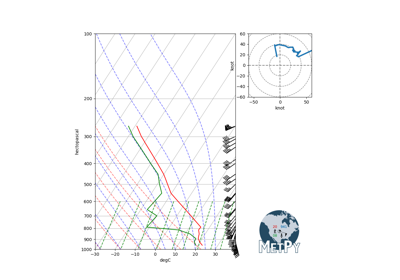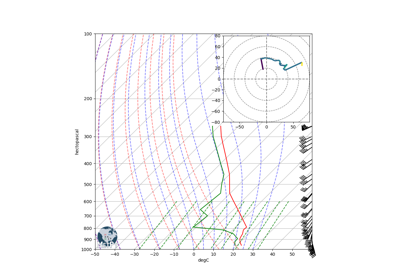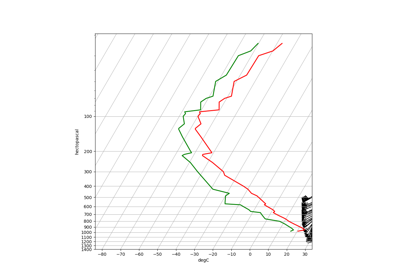Hodograph¶
-
class
metpy.plots.Hodograph(ax=None, component_range=80)[source]¶ Make a hodograph of wind data.
Plots the u and v components of the wind along the x and y axes, respectively.
This class simplifies the process of creating a hodograph using matplotlib. It provides helpers for creating a circular grid and for plotting the wind as a line colored by another value (such as wind speed).
-
ax¶ The underlying Axes instance used for all plotting
Type: matplotlib.axes.Axes
Create a Hodograph instance.
Parameters: - ax (
matplotlib.axes.Axes, optional) – The Axes instance used for plotting - component_range (value) – The maximum range of the plot. Used to set plot bounds and control the maximum number of grid rings needed.
Methods Summary
__init__([ax, component_range])Create a Hodograph instance. add_grid([increment])Add grid lines to hodograph. plot(u, v, **kwargs)Plot u, v data. plot_colormapped(u, v, c[, bounds, colors])Plot u, v data, with line colored based on a third set of data. wind_vectors(u, v, **kwargs)Plot u, v data as wind vectors. Methods Documentation
-
__init__(ax=None, component_range=80)[source]¶ Create a Hodograph instance.
Parameters: - ax (
matplotlib.axes.Axes, optional) – The Axes instance used for plotting - component_range (value) – The maximum range of the plot. Used to set plot bounds and control the maximum number of grid rings needed.
- ax (
-
add_grid(increment=10.0, **kwargs)[source]¶ Add grid lines to hodograph.
Creates lines for the x- and y-axes, as well as circles denoting wind speed values.
Parameters: - increment (value, optional) – The value increment between rings
- kwargs – Other kwargs to control appearance of lines
-
plot(u, v, **kwargs)[source]¶ Plot u, v data.
Plots the wind data on the hodograph.
Parameters: - u (array_like) – u-component of wind
- v (array_like) – v-component of wind
- kwargs – Other keyword arguments to pass to
matplotlib.axes.Axes.plot()
Returns: list[matplotlib.lines.Line2D] – lines plotted
See also
-
plot_colormapped(u, v, c, bounds=None, colors=None, **kwargs)[source]¶ Plot u, v data, with line colored based on a third set of data.
Plots the wind data on the hodograph, but with a colormapped line. Takes a third variable besides the winds and either a colormap to color it with or a series of bounds and colors to create a colormap and norm to control colormapping. The bounds must always be in increasing order. For using custom bounds with height data, the function will automatically interpolate to the actual bounds from the height and wind data, as well as convert the input bounds from height AGL to height above MSL to work with the provided heights.
Simple wrapper around plot so that pressure is the first (independent) input. This is essentially a wrapper around semilogy. It also sets some appropriate ticking and plot ranges.
Parameters: - u (array_like) – u-component of wind
- v (array_like) – v-component of wind
- c (array_like) – data to use for colormapping
- bounds (array-like, optional) – Array of bounds for c to use in coloring the hodograph.
- colors (list, optional) – Array of strings representing colors for the hodograph segments.
- kwargs – Other keyword arguments to pass to
matplotlib.collections.LineCollection
Returns: matplotlib.collections.LineCollection – instance created
See also
-
wind_vectors(u, v, **kwargs)[source]¶ Plot u, v data as wind vectors.
Plot the wind data as vectors for each level, beginning at the origin.
Parameters: - u (array_like) – u-component of wind
- v (array_like) – v-component of wind
- kwargs – Other keyword arguments to pass to
matplotlib.axes.Axes.quiver()
Returns: matplotlib.quiver.Quiver – arrows plotted
-


